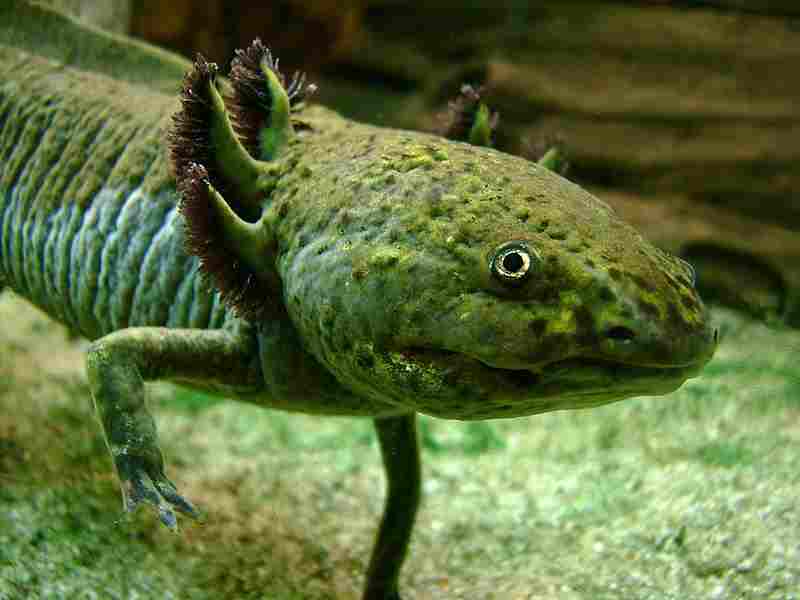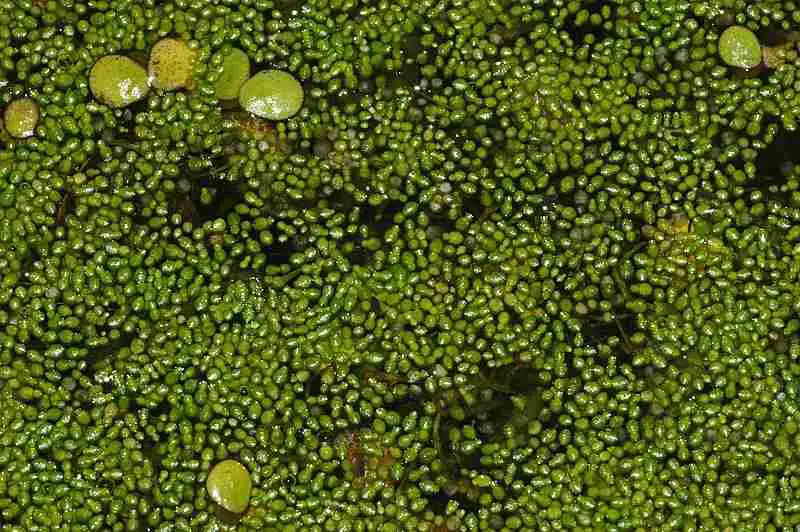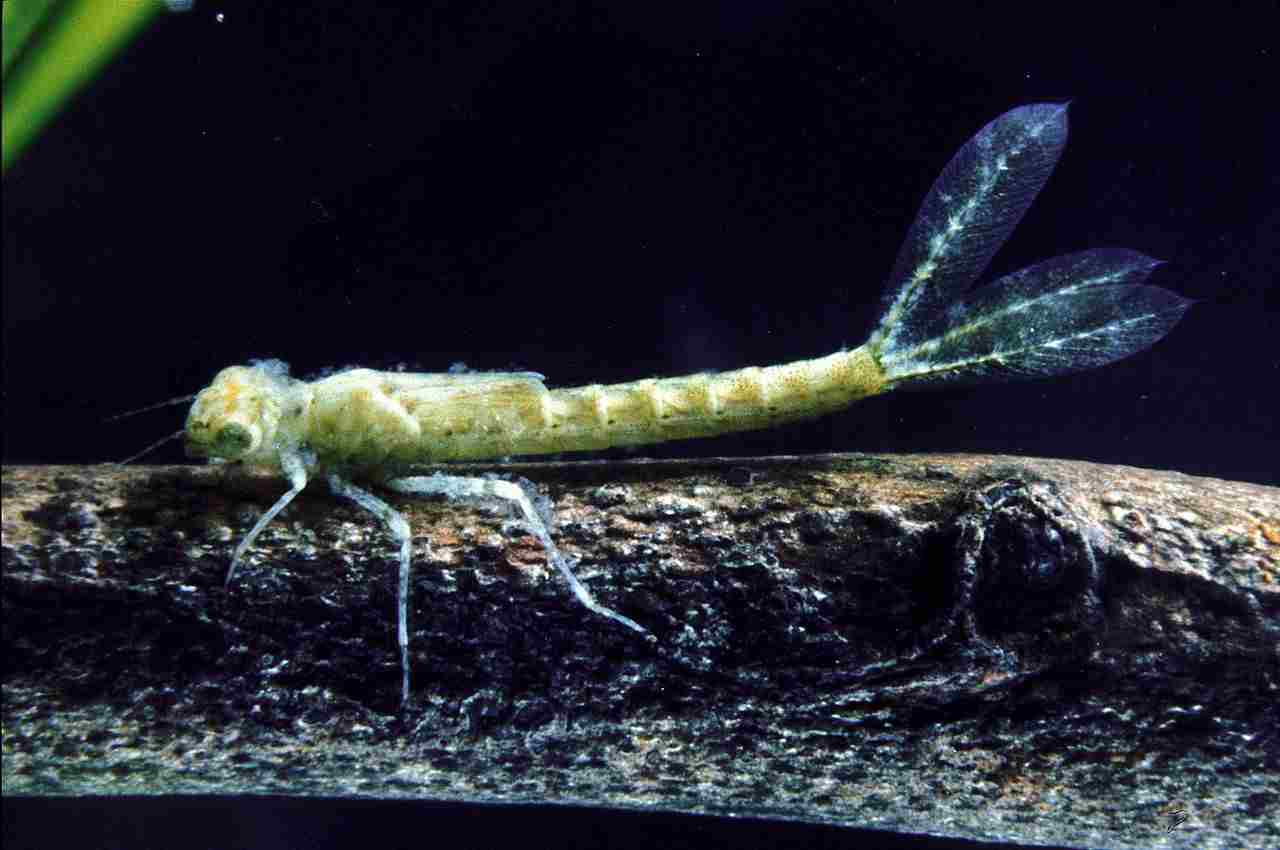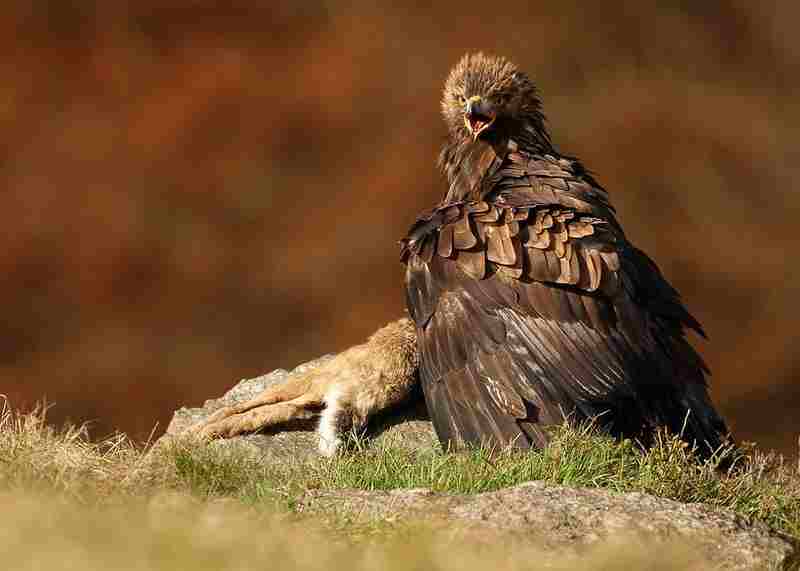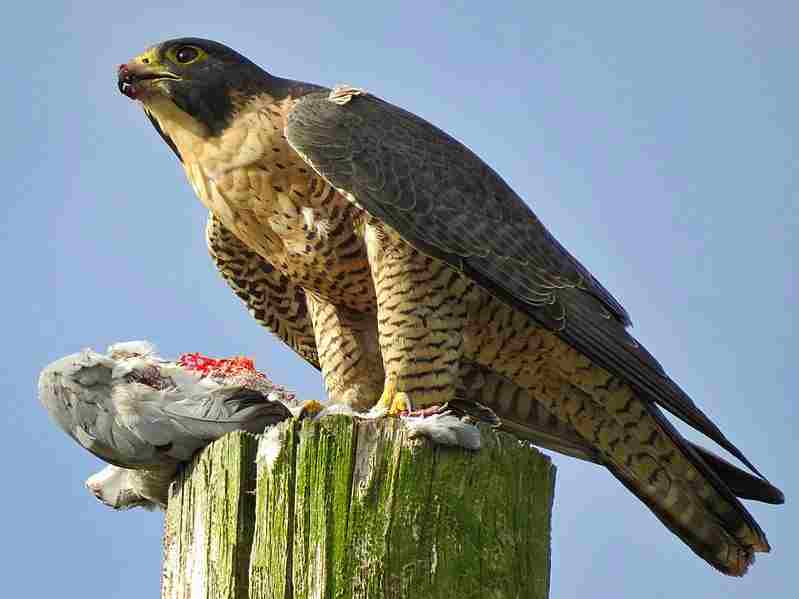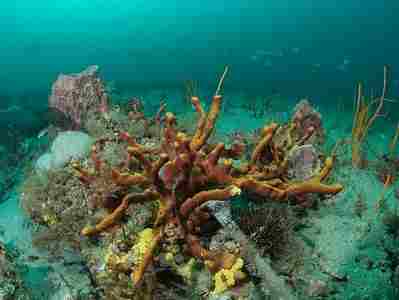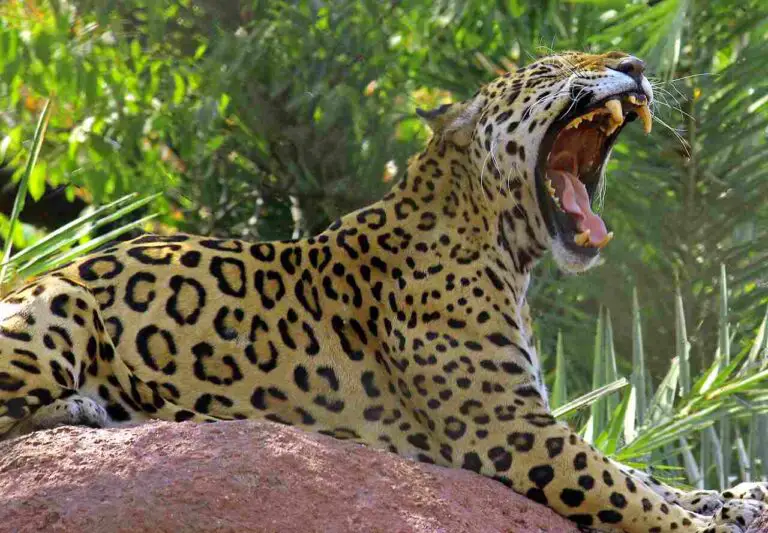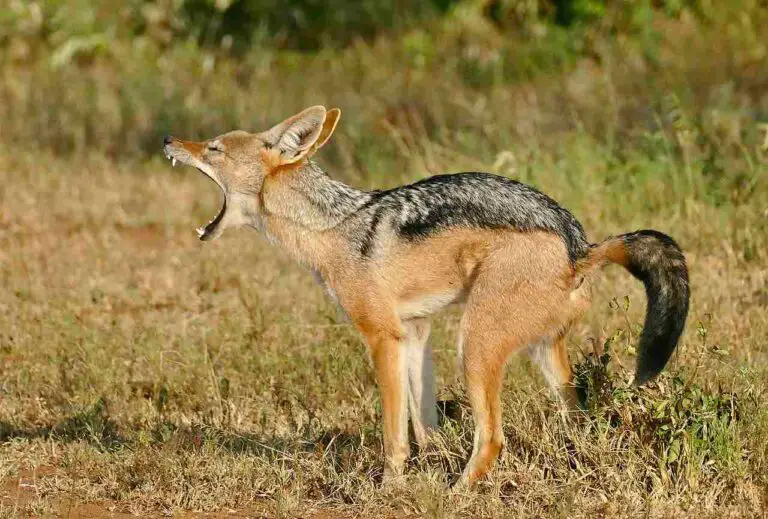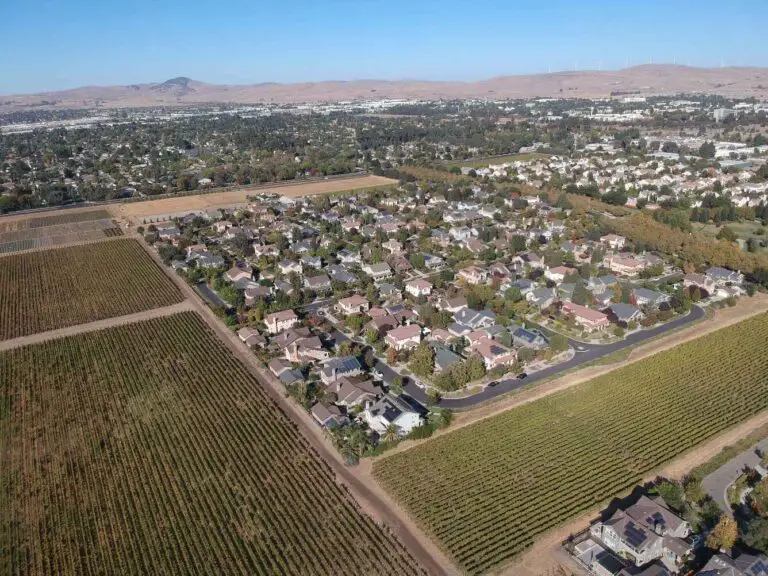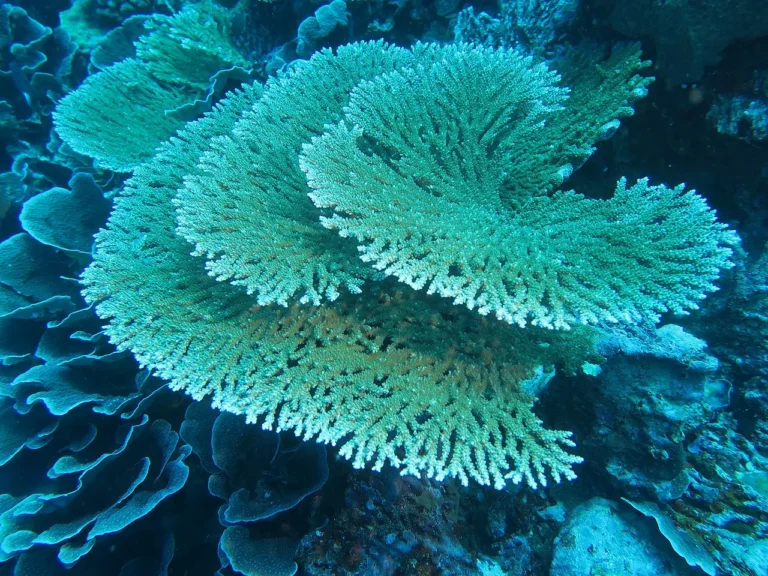Freshwater Food Chain | Freshwater Food Web
Freshwater food chain comprises of producers like; coccolithophores, primary consumers like copepods, secondary consumers like dragonfly nymphs, tertiary consumers like largemouth bass, and quaternary consumers like bald eagle.
Freshwater food web is a complex mosaic formed by the continuous and multi-directional interactions between producers and consumers at various trophic levels.
This article discusses the food chain and web concepts for freshwater ecosystems, as outlined below;
-Freshwater Food Chain
The freshwater food chain is a linear sequence that illustrates the feeding relations between producers, primary consumers, secondary consumers, tertiary and quaternary consumers in freshwater habitats.
1). Primary Producers in Freshwater Ecosystems: Components of the Freshwater Food Chain
Freshwater ecosystems are dynamic environments that play a crucial role in sustaining life on Earth. At the foundation of these ecosystems are primary producers, organisms that harness light energy from solar radiation or chemical energy from inorganic compounds to synthesize organic molecules.
These organisms form the basal level of the food chain, and support a diverse array of aquatic animals. In freshwater ecosystems, primary producers come in various forms, each contributing to the ecological balance in its unique way.
Examples of primary consumers in freshwater are; coccolithophores, diatoms, cyanobacteria, dinoflagellates, watermeal, duckweed, cattail, water hyacinth, and water lily. Some facts about the characteristics and functions of each of these freshwater producers, are briefly highlighted below;
1. Coccolithophores
Coccolithophores are microscopic algae adorned with calcium carbonate plates (coccoliths).
They are usually abundant in open freshwater systems, contributing significantly to the phytoplankton community. Coccolithophores have a vital role to play in the aquatic carbon cycle by fixing carbon dioxide.
2. Diatoms
Diatoms can be described as unicellular algae encased in intricate silica shells.
They are found in lakes, streams, rivers, and ponds, and are major members of freshwater phytoplankton communities.
Diatoms are also essential for oxygen production and nutrient cycling.
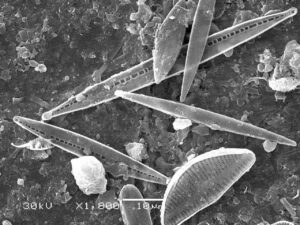
3. Cyanobacteria
Cyanobacteria are a group of photosynthetic bacteria capable of nitrogen fixation.
Commonly known as blue-green algae, cyanobacteria are fundamental in nutrient cycling and serve as a food source for various aquatic organisms.
4. Dinoflagellates
Dinoflagellates are single-celled organisms with flagella for movement.
Found in both freshwater and marine ecosystems, they contribute to the diversity of phytoplankton.
Some species can also exhibit bioluminescence.
5. Watermeal
Watermeal are small sized, free-floating aquatic plants. They are often seen forming greenish mats on the water surface.
Efficient photosynthesizers, these plants play a role in nutrient absorption and biomass production, within their habitat.
6. Duckweed
Duckweeds are small, floating plants that are known to grow rapidly.
They provide shade and habitat for small aquatic organisms, and are also an important food source for various herbivores.
7. Cattail
Cattails can be described emergent macrophytes with distinctive morphological features such as their brown, cylindrical flower spikes.
They thrive in wetland areas, contributing to the stability of shorelines.
Cattails provide habitat and food for birds and insects.
8. Water Hyacinth
Water hyacinths are rapid-growing, pelagic plants with showy lavender flowers.
They are often considered invasive due to rapid colonization, but also serve as habitat and refuge for some aquatic organisms.
9. Water Lily
Water lilies are aquatic flowering plants with large, floating leaves.
They create shaded areas, which influence temperature and light conditions in freshwater habitats. Water lilies are also aesthetically and ecologically important to aquatic ecosystems in general.
In freshwater ecosystems, the diversity of primary producers forms a complex organic network of interdependence, influencing nutrient cycling, oxygen production, and the overall health of the ecosystem.
Understanding the roles of coccolithophores, diatoms, cyanobacteria, dinoflagellates, watermeal, duckweed, cattail, water hyacinth, and water lily is important with regards to the preservation, of the equilibrium of resources in these environments, while ensuring the well-being of the organisms that depend on them.
2). Primary Consumers in Freshwater Ecosystems
Primary consumers in freshwater ecosystems constitute a diverse group of organisms that have a pivotal role to play in transferring energy through the food web/chain.
As herbivores, detritivores, or filter feeders, these organisms feed directly on primary producers, connecting the foundational level of the food chain to higher trophic levels.
Examples of primary consumers in freshwater ecosystems are; krill, copepods, water louse, tadpoles, mudpuppies, and aquatic mollusks.
Examining the features and roles of these primary consumers, sheds light on the nature of organic relationships within freshwater ecosystems.
1. Krill
Krill are small, shrimp-resembling crustaceans that occur in both marine and freshwater environments.
They constitute a vital food source for various freshwater fish and other aquatic organisms. They also have a crucial role to play in nutrient cycling and trophic energy transfer.
2. Copepods
Copepods are tiny crustaceans with a distinctive single eye.
They are typically abundant in freshwater ecosystems, serving as a primary food source for small fish and larvae.
Copepods are efficient filter feeders, contributing to water clarification.
3. Water Louse
Water louse are aquatic crustaceans which possess flattened body structures and segmented appendages.
They function as detritivores, consuming organic waste matter and contributing to nutrient recycling. However, they are classified here as primary consumers due to factors like their size, position in the trophic/biological hierarchy, and heavy consumption of algae-derived materials.
Water louse form an essential link as facilitators of the biodegradation process within freshwater habitats.
4. Tadpole
Tadpoles represent the larval stage of amphibians, such as frogs and toads.
They are primarily herbivores, feeding on algae, detritus, and vascular plant matter.
As an aquatic developmental phase, the tadpole is a crucial transition element in the life cycle of amphibians, connecting freshwater-aquatic and terrestrial ecosystems.
5. Mudpuppy
Mudpuppies are aquatic salamanders that posse external gills throughout their lives.
They are predominantly carnivorous, feeding on small fish, insects, and crustaceans. They are classified as primary consumers here in view of their level of biological and trophic advancement, but may also be classified as secondary consumers in other contexts, due to their carnivorous diet.
Mudpuppies contribute to the regulation of invertebrate populations in freshwater habitats.
6. Aquatic Mollusks
Aquatic mollusks in freshwater ecosystems include gastropods like snails, as well as some species of mussels.
They play diverse roles as filter feeders, herbivores, or detritivores, depending on the species.
Aquatic mollusks influence nutrient cycling and water quality by filtering particles from the water.
The diversity of primary consumers in freshwater ecosystems reflects the dynamic and interconnected nature of these habitats.
Krill, copepods, water louse, tadpoles, mudpuppies, and aquatic mollusks collectively contribute to the recycling of nutrients, energy transfer, and overall ecosystem vitality.
The roles of these organisms are important for sustaining freshwater environments and preserving the processes that establish aquatic food webs. As stewards of these ecosystems, it is essential to recognize and appreciate the significance of primary consumers in maintaining the productivity of freshwater habitats.
3). Secondary Consumers in Freshwater Ecosystems: Components of the Freshwater Food Chain
As the complexity of freshwater ecosystems unfolds, secondary consumers emerge as key players in maintaining the balance of elements, of the food chain or energy pyramid.
These organisms, positioned one trophic level above primary consumers, have a critical role to play in regulating population dynamics and contributing to the wellbeing and diversity of aquatic habitats.
Examples of secondary consumers in freshwater are; dragonfly nymphs, frogs, bluegill fish, brown trout, guppies, and grayling. Their analysis provides insight into the dynamic interactions that typically occur within freshwater ecosystems.
1. Dragonfly Nymph
The dragonfly nymph is simply the aquatic larval stage of the dragonfly.
It is predatory in nature, feeding on small invertebrates, including mosquito larvae and tadpoles.
Dragonfly nymphs contribute to the control of aquatic insect populations and serve as a vital trophic link between lower level consumers and higher predators.
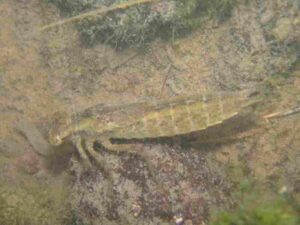
2. Frogs
Frogs are amphibians that transition from tadpoles to adults during their life cycle.
These predatory adults consume a variety of invertebrates and insects, thereby contributing to the regulation of insect populations.
They also serve as indicators of ecosystem health, being sensitive to environmental impacts and changes.
3. Bluegill Fish
Bluegill fish are a type of sunfish commonly found in freshwater lakes and ponds.
They feed on a diet of smaller fish, insects, and other aquatic invertebrates.
As a result they contribute immensely toward controlling populations of smaller organisms, and influence the balance of the ecosystem.
4. Brown Trout
Brown trout are carnivorous fish species found in freshwater streams and rivers.
They prey on smaller fish, aquatic insects, and crustaceans.
Brown trout may indicate the health of freshwater ecosystems, and are sought after by anglers for sport fishing.
5. Guppy
Guppy is a small, livebearing fish native to freshwater habitats.
It feeds on aquatic invertebrates, mosquito larvae, and algae.
Generally, guppy fish are known for their use in mosquito control programs due to their appetite for mosquito larvae.
6. Grayling
Graylings are cold-water fish species inhabiting freshwater streams and rivers.
They primarily feed on aquatic insects and smaller fish. These fish serve as both prey for larger predators and predators themselves, thereby contributing to the ecological balance of the freshwater biome.
Secondary consumers in freshwater ecosystems generally represent a diverse groups of organisms that bridge the gap between primary consumers and top predators.
Dragonfly nymphs, frogs, bluegill fish, brown trout, guppies, and grayling contribute to the regulation of lower trophic levels, influencing the abundance and distribution of species throughout the ecosystem. Understanding the roles of these secondary consumers is essential for effective freshwater ecosystem management, conservation, and the preservation of biodiversity.
4). Tertiary Consumers in Freshwater Ecosystems
In the upper segment of freshwater food chains, tertiary consumers emerge as advanced predators, exerting top-down control on the ecosystem.
These organisms, positioned at the fourth trophic level, play an effective role in regulating lower populations and maintaining the balance of the entire aquatic community.
Example of tertiary consumers in freshwater are; ducks, common carp, kingfishers, snapping turtles, northern pike, largemouth bass, and American eels. Studying these organism sheds light on the intricate dynamics of freshwater ecosystems. Each one is briefly discussed below, in a simplified manner that outlines their characteristics and functions;
1. Ducks
Ducks are waterfowl that occupy various freshwater habitats.
As omnivores, they feed on aquatic vegetation, small fish, and various invertebrates.
Ducks contribute to the control of insect populations and play a role in defining the structure of aquatic plant communities.
2. Common Carp
Common carps are herbivorous fish species that forage on aquatic plants.
They notably alter the physical structure of freshwater habitats by uprooting plants while foraging.
Common carps serve as prey for larger predators, contributing to the transfer of energy through the aquatic food web.
3. Kingfisher
Kingfishers are aerial predators that hunt for fish and aquatic invertebrates.
They typically dive from perches into water to catch prey with their sharp bills.
These birds play a role in controlling fish populations through predation mechanisms; and contribute to the overall sustainability of freshwater ecosystems.
4. Snapping Turtle
Snapping turtles are large, omnivorous turtles with powerful jaws that snap by a rapid reflex mechanism, when objects come between them.
These reptiles feed on a variety of prey, including fish, amphibians, other reptiles and aquatic plants.
They help regulate populations of smaller organisms and contribute to nutrient cycling.
5. Northern Pike
Northern pikes are carnivorous fish with a preference for other fish as their primary prey.
They often function as apex predators in freshwater territories, influencing the abundance and distribution of other fish populations.
Northern pikes exhibit top-down control on the food web, impacting the structure of the entire community.
6. Largemouth Bass
Largemouth bass are predatory fish distinguished by their voracious appetite.
They feed on smaller fish, insects, and occasionally small mammals or amphibians.
Largemouth bass play an important role in controlling populations of smaller fish, and maintaining ecosystem stability.
7. American Eel
The American eel is a catadromous fish with a complex life cycle, migrating between freshwater and marine environments.
These fish are opportunistic feeders, which consume a variety of prey including fish, crustaceans, and insects.
They serve as both predators and prey, contributing to the dynamic nature of freshwater ecosystems.
Tertiary consumers in freshwater ecosystems, including ducks, common carp, kingfishers, snapping turtles, northern pike, largemouth bass, and American eels, represent advanced predators that shape the ecological structure and functionality of these habitats.
Their roles in controlling populations and influencing the distribution of species have cascading effects throughout the food web. Understanding the ecological significance of these apex predators is essential for effective conservation and management of freshwater ecosystems.
5). Quaternary Consumers in Freshwater Ecosystems: Components of the Freshwater Food Chain
As we delve into the intricate layers of freshwater ecosystems, quaternary consumers emerge as the ultimate pinnacle of the food web.
These apex predators occupy the highest trophic level, exerting top-down control on the intricate dynamics of aquatic communities below them.
Some quaternary consumers in freshwater ecosystems are; river dolphins, alligators, crocodiles, river otters, caimans, and bald eagles. Their study provides insight into the unique and vital contributions of these apex predators to the vitality and stability of freshwater ecosystems.
1. River Dolphin
River dolphins are cetaceans adapted to freshwater habitats, such as the Amazon River.
They are predatory, feeding on various fish species.
River dolphins serve as indicators of freshwater ecosystem wellbeing, and contribute to the regulation of fish populations.
2. Alligator
Alligators are large reptiles with a broad snout and armored body.
They are apex predators that feed on fish, amphibians, and other aquatic organisms, including seabirds.
These reptiles influence the structure of aquatic communities by controlling populations of prey species.
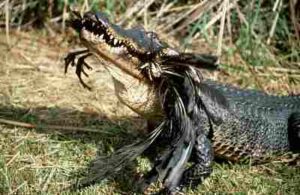
3. Crocodile
Crocodiles are semi-aquatic reptiles known for their powerful jaws.
They are also apex predators that prey on fish, birds, and mammals.
Crocodiles play a critical role in regulating the populations of prey species and influencing the trophic dynamics of freshwater ecosystems.
4. River Otter
River otters are well-known, semi-aquatic mammals with sleek, streamlined bodies.
As predators, they feed on fish, amphibians, and invertebrates.
River otters contribute to the balance of freshwater ecosystems by controlling populations of smaller organisms.
5. Caiman
Caiman is a crocodilian species inhabiting freshwater environments in Central and South America.
Like other aquatic reptiles it is predatory, feeding on fish, amphibians, fellow reptiles, and mammals.
Caimans participate in top-down control, influencing the abundance and distribution of prey species.
6. Bald Eagle
Bald eagles are large raptors known for their distinctive white head and tail.
As apex predators they primarily feed on fish, but also consume waterfowl and other prey.
Bald eagles play a key role in controlling populations of fish and contributing to the overall balance of aquatic ecosystems.
Quaternary consumers, including river dolphins, alligators, crocodiles, river otters, caimans, and bald eagles, represent the apex predators that govern the intricate dynamics of freshwater ecosystems. Their presence and ecological roles have cascading effects throughout the food web, defining the structure and health of these habitats.
Monitoring and preserving the roles of these apex predators are essential steps for the conservation and sustainable management of freshwater ecosystems.
6). Decomposers and Detritivores in Freshwater Ecosystems
Within the intricate tapestry of freshwater ecosystems, decomposers and detritivores have a fundamental role to play in recycling organic matter and maintaining ecological stability.
These organisms, ranging from microscopic bacteria to macroscopic invertebrates, contribute to the breakdown of detritus and the release of essential nutrients from waste biomass back into the ecosystem.
Examples of decomposers and detritivores in freshwater are; bacteria, fungi, aquatic worms, gastropods, crayfish, and crabs. An examination of their features and functions can provide insight into the vital role played by these organisms.
1. Bacteria
Bacteria are versatile, microscopic organisms abundant in freshwater environments.
They decompose organic matter through processes like aerobic and anaerobic respiration.
Their activities are essential for nutrient cycling, as they break down complex compounds into simpler products.
2. Fungi
Fungi are saprophytic decomposers that play an important role in breaking down organic matter.
They are commonly found on decaying plant material in freshwater habitats.
Fungi assist in nutrient release and contribute to the formation of humus.
3. Aquatic Worms
In general, aquatic worms include various species of limbless, usually segmented invertebrates that burrow into sediment and organic matter.
Within freshwater ecosystems they contribute to the breakdown of plant and animal remains through physical and biological processes.
Aquatic worms enhance nutrient cycling by increasing surface area for bacterial colonization.
4. Gastropods
Snails and other gastropods may inhabit freshwater ecosystems.
Several of these mollusks are detritivorous and feed on decaying plant matter and algae, contributing to nutrient recycling.
These species act as detritivores, processing organic material in aquatic environments.
5. Crayfish
Crayfish are freshwater crustaceans that often play dual roles as detritivores and opportunistic predators.
They consume detritus and fragmented organic substrates, contributing to nutrient release.
Crayfish facilitate the breakdown of large organic particles through mechanical processes.
6. Crabs
Some freshwater crab species contribute to the decomposition of organic matter.
These crabs scavenge on detritus and decaying plant material, aiding in nutrient cycling.
They influence the physical structure of the substrate through burrowing activities.
Decomposers and detritivores in freshwater ecosystems form a critical link in the nutrient cycling process, recycling organic matter and maintaining ecosystem vitality. Bacteria, fungi, aquatic worms, gastropods, crayfish, and crabs collectively ensure the efficient breakdown of detritus, releasing essential nutrients back into the environment.
Recognizing and preserving the roles of these organisms is essential for the sustainable functioning of freshwater ecosystems, because they contribute to the overall resilience and productivity of these habitats.
-Freshwater Food Web
The freshwater food web is a complex ecological network of trophic interactions between diverse species, at various levels of the ecosystem. This network can be simplified into a series of distinct, hypothetical linear sequences or food chains, where the individual organisms and their relationships can be analyzed.
It must be noted that since food chains are only idealized and simplified models, the freshwater food web is a more realistic depiction of energy transfer, feeding and survival in this ecosystem. Also, because many of the organisms discussed here appear in more than one food chain, their descriptions for such appearances are often repetitive.
1). Food Chain 1: A Hypothetical Component of the Freshwater Food Web
Components: Coccolithophores, cyanobacteria, duckweed, water lily (Trophic Level 1)→Copepods, tadpole, aquatic mollusks (Trophic Level 2)→Frogs, brown trout, grayling (Trophic Level 3)→Common carp, snapping turtle, kingfisher (Trophic Level 4)→River dolphin, caiman (Trophic Level 5)
*Trophic Level 1
Producers in Chain 1 of the freshwater food web are; coccolithophores, cyanobacteria, duckweeds, and water lilies.
Coccolithophores are microscopic algae which engage in photosynthesis, converting sunlight into chemical energy. Such photosynthetic energy serves as the trophic basis of the entire food chain.
Cyanobacteria similarly contribute to primary production through photosynthesis, producing organic biomass from inorganic substances.
Duckweed are aquatic plants which support the process of photosynthesis in freshwater ecosystems, converting solar energy into chemical energy stored in their tissues.
Water lilies are also primary producers that engage in photosynthesis, utilizing sunlight to produce energy-rich compounds.
*Trophic Level 2
Primary consumers in Chain 1 are; copepods, tadpoles and aquatic mollusks.
Copepods are small crustaceans with herbivorous habits; feeding on primary producers like coccolithophores and duckweed.
Tadpoles are also herbivores, consuming plant material such as duckweed and algae.
Aquatic mollusks include some species of freshwater snails, which contribute to the breakdown of organic matter, consuming detritus and significant quantities of plant material.
*Trophic Level 3
The secondary consumers here are; frogs, brown trout, and grayling.
Frogs are carnivores, preying on insects and crustaceans like copepods, and thereby participating in energy transfer from herbivores to carnivores.
Brown trout are piscivorous fish, which tend to feed on smaller fish and other lower consumers like tadpoles, further transferring energy up the trophic levels.
Grayling are similar to brown trout, and also function as piscivores, consuming smaller fish in the ecosystem.
*Trophic Level 4
Common carp, snapping turtle and kingfisher are all tertiary consumers in Chain.
Common carp are omnivores, feeding on a variety of organisms including aquatic plants, small invertebrates, and smaller fish.
As omnivores, snapping turtles may consume both plant material and animal biomass, participating in the effective recycling of organic material in the ecosystem.
Carnivorous birds like kingfishers play a role in controlling the populations of smaller organisms such as fish and aquatic invertebrates.
*Trophic Level 5
The quaternary consumers are; river dolphin and caiman.
As top predators, river dolphins feed on a variety of fish, including common carp and brown trout, contributing to energy transfer and population control.
In similar manner, caimans act as apex predators, preying on organisms like snapping turtles and river dolphins, maintaining ecological balance.
Recurring Organisms Across Food Chains
Some organisms in Chain 1 that occur in other food chains discussed in this article, are highlighted below;
1. Coccolithophores: Present in Food Chain 1 and Food Chain 4.
2. Duckweed: Present in Food Chain 1 and Food Chain 3.
3. Tadpole: Present in Food Chain 1, Food Chain 3, and Food Chain 5.
4. Aquatic Mollusks: Present in Food Chain 1, Food Chain 3, and Food Chain 5.
5. Brown Trout: Present in Food Chain 1, Food Chain 3, and Food Chain 5.
6. Kingfisher: Present in Food Chain 1 and Food Chain 3.
7. Snapping Turtle: Present in Food Chain 1 and Food Chain 4.
8. Caiman: Present in Food Chain 1 and Food Chain 4.
Interconnected Linkages and the Freshwater Food Web
The recurrence of organisms across different food chains creates linkages, forming a complex freshwater food web.
For instance, organisms like coccolithophores and duckweed serve as foundational elements, linking primary production to higher trophic levels.
Meanwhile, organisms like tadpoles, aquatic mollusks, brown trout, and kingfishers create connections between trophic levels, facilitating the flow of energy. These interconnected linkages highlight the interdependence of organisms in freshwater ecosystems and emphasize the importance of maintaining a balanced and diverse community for the overall health of the ecosystem.
2). Food Chain 2
Components: Diatoms, watermeal, water hyacinth (Trophic Level 1)→Krill, water louse, common mudpuppy (Trophic Level 2)→Dragonfly nymph, guppy, frogs (Trophic Level 3)→Ducks, American eel, largemouth bass (Trophic Level 4)→Bald eagle, alligator (Trophic Level 5)
*Trophic Level 1
The primary producers in Chain 2 of the freshwater food web are; diatoms, watermeal, and water hyacinths.
Diatoms are microscopic algae involved in photosynthesis, producing organic compounds from light energy.
Watermeal are small floating plants that contribute to primary production through photosynthesis.
Water hyacinths are aquatic plants engaged in photosynthesis, converting solar energy into chemical energy stored in their tissues.
*Trophic Level 2
Primary consumers in Chain 2 are; krill, water louse, and common mudpuppy.
Krill are small crustaceans that serve as herbivores, consuming diatoms and other planktonic primary producers.
Water lice are aquatic invertebrates that act as detritivores, breaking down organic matter in the water.
Common mudpuppies are amphibians that contribute to the breakdown of detritus and regulation small aquatic (heterotroph) populations.
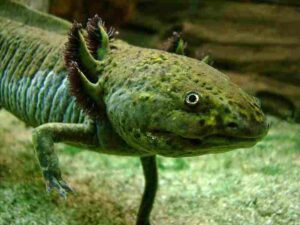
*Trophic Level 3
The secondary consumers in Chain 2 are; dragonfly nymph, guppy, and frog.
Dragonfly nymphs are larval aquatic insects preying on other aquatic organisms, including guppies and water lice.
Guppies are small fish serving as herbivores as well as prey for higher trophic levels.
Frogs are carnivorous amphibians that contribute to the control of insect populations.
*Trophic Level 4
The tertiary consumers are; ducks, American eels, and largemouth bass.
Ducks are omnivorous waterfowl that feed on aquatic plants, small fish, and invertebrates.
American eels are distinctive catadromous fish with elongated bodies and advanced carnivorous adaptations, that serve as both scavengers and predators.
Largemouth bass are also carnivorous fish preying on smaller fish, including guppies, and contributing to energy transfer.
*Trophic Level 5
Bald eagle and alligator are quaternary consumers at the apex level of this hypothetical freshwater food chain.
Bald eagle is an apex predator bird preying on fish, waterfowl, and other aquatic organisms.
Alligators are top predatory reptiles that help maintain ecological balance by controlling the populations of various species.
Recurring Organisms Across Food Chains
Below is a list of all out-linking organisms in Food Chain 2, that also occur in other food chains;
1. Diatoms: Present in Food Chain 2 and Food Chain 5.
2. Watermeal: Present in Food Chain 2 and Food Chain 5.
3. Krill: Present in Food Chain 2 and Food Chain 4.
4. Water Louse: Present in Food Chain 2 and Food Chain 5.
5. Guppy: Present in Food Chain 2 and Food Chain 5.
6. Frogs: Present in Food Chain 2, Food Chain 1, and Food Chain 4.
7. Ducks: Present in Food Chain 2, Food Chain 4, and Food Chain 5.
8. American Eel: Present in Food Chain 2 and Food Chain 4.
9. Largemouth Bass: Present in Food Chain 2 and Food Chain 5.
10. Bald Eagle: Present in Food Chain 2 and Food Chain 5.
Interconnected Linkages and the Freshwater Food Web
The recurrence of organisms across different food chains creates linkages that form the foundation of a dynamic freshwater food web.
For example, diatoms and watermeal, as primary producers, create connections between trophic levels by being consumed by herbivores like krill and guppies. Predators such as frogs, ducks, largemouth bass, bald eagles, and alligators establish links between trophic levels, contributing to the flow of energy and the regulation of population dynamics.
The interconnectedness of these organisms leads to the intricate relationships in freshwater ecosystems and highlights the importance of preserving biodiversity for the long-term sustenance of the ecosystem.
3). Food Chain 3: A Hypothetical Component of the Freshwater Food Web
Components: Dinoflagellates, cattail, duckweed, cyanobacteria (Trophic Level 1)→Tadpole, aquatic mollusks, copepods (Trophic Level 2)→Brown trout, bluegill fish, grayling (Trophic Level 3)→Northern pike, common carp, kingfisher (Trophic Level 4)→Crocodile, river otter (Trophic Level 5)
*Trophic Level 1
The primary producers in Food Chain 3 are; dinoflagellates, cattails, duckweeds and cyanobacteria.
Dinoflagellates are microscopic aquatic planktons involved in photosynthesis, contributing to primary production.
Cattails are emergent macrophyte plants providing habitat and contributing to primary production.
Duckweeds are floating aquatic plant engaged in photosynthesis.
Cyanobacteria are photosynthetic bacteria contributing to nutrient cycling and primary production.
*Trophic Level 2
Tadpoles, aquatic mollusks and copepods are the primary consumers here.
Tadpoles represent the herbivorous larval stage of amphibians, feeding on aquatic plants like duckweed.
Aquatic mollusks are detritivores and herbivores contributing to the breakdown of organic matter.
Copepods are small crustaceans serving as herbivores, feeding on phytoplankton like dinoflagellates.
*Trophic Level 3
The secondary consumers in Chain 3 are; brown trout, bluegill fish, and graylings.
Brown trout are carnivorous fish preying on smaller fish like copepods and tadpoles.
Bluegill fish are omnivorous fish consuming aquatic invertebrates, smaller fish, and detritus.
Graylings represent another fish species that acts as a predator and herbivore.
*Trophic Level 4
Northern pike, common carp, and kingfisher are tertiary consumers in this food chain.
Northern pike is a predatory fish that preys on smaller fish like bluegill and brown trout.
Common carp is an omnivorous fish feeding on aquatic plants, invertebrates, and detritus.
Kingfisher is a carnivorous bird preying on fish, including northern pike and common carp.
*Trophic Level 5
Crocodiles and river otters are apex predators in Chain 3.
Crocodile is an apex predator reptile feeding on various organisms, including fish and amphibians.
River otter is a carnivorous mammal preying on fish and contributing to the control of smaller populations.
Recurring Organisms Across Food Chains
Some of the recurring organisms in Chain 3 and their locations of recurrence are listed as follows;
1. Duckweed: Present in Food Chain 3 and Food Chain 1.
2. Copepods: Present in Food Chain 3 and Food Chain 1.
3. Tadpole: Present in Food Chain 3, Food Chain 1, and Food Chain 5.
4. Aquatic Mollusks: Present in Food Chain 3, Food Chain 1, and Food Chain 5.
5. Brown Trout: Present in Food Chain 3, Food Chain 1, and Food Chain 5.
6. Kingfisher: Present in Food Chain 3 and Food Chain 1.
Interconnected Linkages and the Freshwater Food Web
The recurrence of organisms across different food chains establishes linkages that contribute to the formation of a freshwater food web. For example, duckweed, copepods, tadpoles, aquatic mollusks, brown trout, and kingfishers create connections between trophic levels, showcasing the interdependence of various species.
These linkages facilitate the flow of energy through the ecosystem, with each organism playing a specific role in the balance and health of the freshwater environment. The food web formed by these linkages is a model of the complexity and resilience of freshwater ecosystems.
4). Food Chain 4
Components: Water hyacinth, coccolithophores, water lily (Trophic Level 1)→Common mudpuppy, krill (Trophic Level 2)→Frogs, dragonfly nymph (Trophic Level 3)→Ducks, snapping turtle, American eel (Trophic Level 4)→River otter, caiman (Trophic Level 5)
*Trophic Level 1
Water hyacinth is an aquatic plant engaging in photosynthesis, converting sunlight into chemical energy.
Coccolithophores are planktonic algae involved in photosynthesis, contributing to primary production.
Water lily is another aquatic plant that photosynthesizes and contributes to the energy available in the ecosystem.
*Trophic Level 2
Common mudpuppy is an aquatic amphibian that feeds on small invertebrates, contributing to the regulation of their populations.
Krill are planktonic crustaceans that serve as herbivores, consuming phytoplankton like coccolithophores.
*Trophic Level 3
Frogs are predatory amphibians that feed on aquatic insects, including fellow secondary consumers like dragonfly nymphs, and lower organisms like zooplankton.
Dragonfly nymphs are aquatic insects that are predatory in nature, feeding on smaller organisms like krill.
*Trophic Level 4
Ducks are omnivorous waterfowl that consume aquatic plants, small invertebrates, and small fish.
Snapping turtle is an omnivorous turtle species that scavenges on detritus and feeds on small organisms.
American eel is an adaptive fish that serves as both a scavenger and a predator.
*Trophic Level 5
River otters are carnivorous mammals that prey on fish and contribute to the control of smaller populations.
Caiman is a top predator reptile that maintains ecological stability in its aquatic habitat by controlling populations of various species.
Recurring Organisms Across Food Chains
1. Coccolithophores: Present in Food Chain 4 and Food Chain 1.
2. Water Lily: Present in Food Chain 4 and Food Chain 1.
3. Krill: Present in Food Chain 4 and Food Chain 2.
4. Frogs: Present in Food Chain 4, Food Chain 1, and Food Chain 2.
5. Snapping Turtle: Present in Food Chain 4 and Food Chain 1.
6. American Eel: Present in Food Chain 4 and Food Chain 2.
7. River Otter: Present in Food Chain 4 and Food Chain 3.
8. Caiman: Present in Food Chain 4 and Food Chain 1.
Interconnected Linkages and the Freshwater Food Web
The recurrence of organisms across different food chains creates linkages, forming a complex freshwater food web.
For instance, coccolithophores, water lilies, krill, frogs, snapping turtles, American eels, river otters, and caimans create connections between trophic levels, showcasing the interdependence of various species. These organisms contribute to the flow of energy through the ecosystem, with each trophic level supporting and influencing the others.
The food web formed by these linkages underscores the complexity and resilience of freshwater ecosystems, where each organism plays a specific role in maintaining the equilibrium and health of the environment.
5). Food Chain 5: A Hypothetical Component of the Freshwater Food Web
Components: Diatoms, watermeal, dinoflagellates (Trophic Level 1)→Water louse, tadpole, aquatic mollusks (Trophic Level 2)→Guppy, brown trout, grayling (Trophic Level 3)→Largemouth bass, northern pike, ducks (Trophic Level 4)→River dolphin, bald eagle (Trophic Level 5)
*Trophic Level 1
Diatoms are a group of algae engaged in photosynthesis, producing organic compounds from sunlight.
Watermeal are small pelagic plants contributing to primary production through photosynthesis.
Dinoflagellates are microscopic aquatic organisms also involved in photosynthesis.
*Trophic Level 2
Water lice are aquatic invertebrates acting as detritivores, breaking down organic matter in the water.
Tadpoles are the herbivorous larval stage of amphibians, feeding on aquatic plants like watermeal.
Aquatic mollusks can be herbivorous and opportunistic contributing to the breakdown of organic matter.
*Trophic Level 3
Guppies are small fish serving as herbivores, zooplankton consumers, and prey for higher trophic levels.
Brown trout are carnivorous fish preying on smaller fish like guppies.
Grayling is a versatile fish species that acts as a predator and herbivore.
*Trophic Level 4
Largemouth bass is a carnivorous fish preying on smaller fish and contributing to energy transfer.
Northern pike is a top predator fish feeding on smaller fish, including largemouth bass.
Ducks are opportunistic waterfowl that consumes aquatic plants, small invertebrates, and small fish.
*Trophic Level 5
River dolphin is an apex predator feeding on fish, including largemouth bass and northern pike.
Bald eagle is a predatory bird that can feed on fish, waterfowl, and other aquatic organisms.
Recurring Organisms Across Food Chains
1. Diatoms: Present in Food Chain 5 and Food Chain 2.
2. Watermeal: Present in Food Chain 5 and Food Chain 2.
3. Dinoflagellates: Present in Food Chain 5 and Food Chain 3.
4. Water Louse: Present in Food Chain 5 and Food Chain 2.
5. Tadpole: Present in Food Chain 5, Food Chain 1, and Food Chain 3.
6. Aquatic Mollusks: Present in Food Chain 5, Food Chain 1, and Food Chain 3.
7. Guppy: Present in Food Chain 5 and Food Chain 2.
8. Brown Trout: Present in Food Chain 5, Food Chain, and Food Chain 3.
9. Grayling: Present in Food Chain 5, Food Chain 1, and Food Chain 3.
10. Largemouth Bass: Present in Food Chain 5 and Food Chain 2.
11. Northern Pike: Present in Food Chain 5 and Food Chain 3.
12. Ducks: Present in Food Chain 5, Food Chain 2, and Food Chain 4.
13. River Dolphin: Present in Food Chain 5 and Food Chain 1.
14. Bald Eagle: Present in Food Chain 5 and Food Chain 2.
Interconnected Linkages and the Freshwater Food Web
The recurrence of organisms across different food chains establishes linkages, forming a dynamic freshwater food web. For example, diatoms, watermeal, dinoflagellates, water lice, tadpoles, aquatic mollusks, guppies, brown trout, grayling, largemouth bass, northern pike, ducks, river dolphins, and bald eagles create connections between trophic levels, showcasing the interdependence of various species.
These interconnections are channels facilitating the flow of energy through the ecosystem, with each trophic level supporting and influencing the others. The food web formed by multiple trophic linkages underscores the complexity and resilience of freshwater ecosystems, where each organism plays a multidimensional role in maintaining the biotic functionality of the environment.
An Overview of the Freshwater Food Web Based On Trophic Linkages and Feeding Interactions
The freshwater food web is a complex network of trophic linkages and feeding interactions that connect various organisms in aquatic ecosystems.
The interactions between producers, consumers, and decomposers create a dynamic and interconnected web of life, illustrating the flow of energy and nutrients through the ecosystem. Drawing on the discussions of the hypothetical food chains in this article, we can highlight instances of such linkages:
Primary Producers (Trophic Level 1)
Diatoms, Coccolithophores, Dinoflagellates, Watermeal, Duckweed, Cattail, Water Hyacinth, Water Lily: These primary producers engage in photosynthesis, converting sunlight into chemical energy. They form the base of the food web, providing energy to herbivores.
Herbivores
Krill, Copepods, Tadpole, Aquatic Mollusks, Water Louse: These organisms consume primary producers, forming the second trophic level. For example, krill and copepods feed on diatoms and coccolithophores.
Lower Predators
Guppy, Brown Trout, Grayling, Frogs, Dragonfly Nymph: Herbivores and insectivores form the third trophic level, preying on herbivores and continuing the energy transfer.
Mid-Level Predators
Common Carp, Snapping Turtle, Kingfisher, Ducks, American Eel, Largemouth Bass, Northern Pike: Carnivores, omnivores, and piscivores make up the third and fourth trophic levels, consuming herbivores and smaller carnivores. For instance, ducks feed on aquatic mollusks and small fish, while northern pike prey on largemouth bass.
Apex Predators
River Dolphin, Caiman, Crocodile, River Otter, Bald Eagle, Alligator: Apex predators at the apex trophic level consume organisms from lower trophic levels, controlling populations and influencing the overall structure of the ecosystem.
Instances of Recurring Organisms Across Food Chains
Coccolithophores, Duckweed, Tadpole, Aquatic Mollusks, Brown Trout, Kingfisher, Snapping Turtle, American Eel, River Otter, Caiman, Bald Eagle, Guppy, Northern Pike, and Ducks appear in multiple food chains, creating linkages between different trophic levels and ecosystems.
Building the Freshwater Food Web
The recurrence of organisms across various food chains creates interconnected linkages, forming the basis of the freshwater food web. For example, a tadpole that appears in one food chain might be prey for frogs in another. Similarly, ducks that feed on various organisms contribute to the energy flow through different trophic levels.
The presence of organisms like coccolithophores, water lilies, guppies, and frogs in multiple food chains underscores their importance as central players in the food web, linking different habitats and trophic levels.
Apex predators such as river dolphins, eagles, and caimans exert top-down control on the ecosystem, influencing the abundance and distribution of species at lower trophic levels.
Based on the concepts explained in this article, it can be said that the freshwater food web is a complex and interconnected system where each organism plays a specific role in energy transfer, nutrient cycling, and maintaining the overall health and balance of the ecosystem. The recurrence of organisms across various food chains creates linkages that emphasize the interdependence of species and the intricate dynamics within freshwater ecosystems.
Conclusion
The freshwater food chain comprises of;
Primary Producers
Primary Consumers
Secondary Consumers
Tertiary Consumers
Decomposers and Detritivores
The freshwater food web is a network of multidimensional organic interactions at all major levels of the trophic hierarchy. It can be resolved into simple linear models (food chains), for discussion purposes. Such food chains are outlined below;
Food Chain 1: Coccolithophores, cyanobacteria, duckweed, water lily (Trophic Level 1)→Copepods, tadpole, aquatic mollusks (Trophic Level 2)→Frogs, brown trout, grayling (Trophic Level 3)→Common carp, snapping turtle, kingfisher (Trophic Level 4)→River dolphin, caiman (Trophic Level 5)
Food Chain 2: Diatoms, watermeal, water hyacinth (Trophic Level 1)→Krill, water louse, common mudpuppy (Trophic Level 2)→Dragonfly nymph, guppy, frogs (Trophic Level 3)→Ducks, American eel, largemouth bass (Trophic Level 4)→Bald eagle, alligator (Trophic Level 5)
Food Chain 3: Dinoflagellates, cattail, duckweed, cyanobacteria (Trophic Level 1)→Tadpole, aquatic mollusks, copepods (Trophic Level 2)→Brown trout, bluegill fish, grayling (Trophic Level 3)→Northern pike, common carp, kingfisher (Trophic Level 4)→Crocodile, river otter (Trophic Level 5)
Food Chain 4: Water hyacinth, coccolithophores, water lily (Trophic Level 1)→Common mudpuppy, krill (Trophic Level 2)→Frogs, dragonfly nymph (Trophic Level 3)→Ducks, snapping turtle, American eel (Trophic Level 4)→River otter, caiman (Trophic Level 5)
Food Chain 5: Diatoms, watermeal, dinoflagellates (Trophic Level 1)→Water louse, tadpole, aquatic mollusks (Trophic Level 2)→Guppy, brown trout, grayling (Trophic Level 3)→Largemouth bass, northern pike, ducks (Trophic Level 4)→River dolphin, bald eagle (Trophic Level 5)
